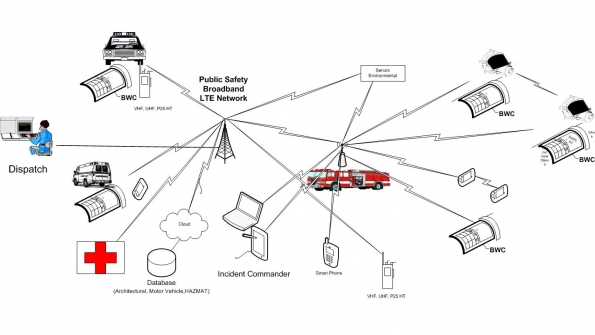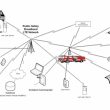Future First Responders and FirstNet: Response to a multiple-vehicle accident (MVA) scenario
What is in this article?
Scenario: EMS responding
EMS apparatus and personnel are en route and consist of two ambulances from the local ambulance corps. The EMS vehicles are identified as assets that are en route, and their icons on the ICS tablet identify their locations and ETAs.
While en route to the incident, each EMS apparatus is provided a telemetry and video link to improve their situational awareness. The EMS Coordinator instructs the various EMS apparatus where to pre-stage their vehicles before advancing on the scene, so fire can secure the location. The triage and rehab locations are identified by the EMS coordinator, and this information—along with the pre-stage location—is sent to the chief via a pop-up message, with the locations identified on his visual map.
Knowing that apparatus and personnel are en route, along with the MA assets requested, the chief indicates on the ICS tablet where the fire apparatus should be placed, including the staging area for rescue equipment. The fill location for water is reconfirmed as the tanker fill team arrives and confirms a good draft is achieved. This information is also send to dispatch and broadcast to all responding assets.
The chief assigns officers to each of the motor vehicles involved with the MVA and continues to monitor the situation as apparatus and personnel arrive.
Fire and Rescue apparatus, as well as the Police, arrive on scene. Fire rescue is instructed via CID to remain at a distance, while the first fire apparatus secures and the second apparatus protects the scene.
The chief re-verifies the apparatus assignments and makes no changes to the original order. The officers for the first and second apparatus exit the vehicles with BWC and officer tools.
The First-Due Fire Apparatus is assigned to the LP Truck, with the following personnel assignments:
-
Fire Officer 1: Accesses LP Truck
-
Provides video feed to chief and reports via radio using an LTE intrinsically safe device on BWC with a throat microphone.
- Driver seriously injured, conscious but speaking French
- Odor of propane detected
-
Provides video feed to chief and reports via radio using an LTE intrinsically safe device on BWC with a throat microphone.
- Fire Team 1 (nozzle and back-up)
- Pull 2.5” hose and get into position with charged line
- SCBA donned, no mask
-
Fire Team 2 (irons and can)
- Establishes backup 2.5” hose line and gets into position with a charged line (filled with water)
- SCBA donned, no mask
- Engine Officer (chauffer) mans pumps (after securing vehicle)
Second-Due Fire Apparatus (tanker)
- Establishes water supply to First-Due apparatus
- Sets up pool
Two fire personnel arrive on scene with their own vehicles. They activate their BWCs and await instructions. The chief is informed of two more personnel arriving on scene, and he assigns them to the first-due rescue team. The first-due rescue officer is informed of additional resources over LTE radio through his BWC.
All personnel are informed of the situation, and Fire Police and Police are instructed to quickly secure road and help clear the existing civilian vehicles in the incident area.
Fire Team 1 dons SCBA masks with the augmented thermal display active (Figure 5) and begins applying a water curtain to the LP truck near the suspected rupture. The augmented display giving thermal imaging is displayed on SCBA mask. At same time, the fire officer approaches the LP truck cab and is able to open door, reaches over the victim and turns off vehicle and secures keys.
Figure 5. SCBA augmented vision. Click the image to enlarge.
The SCBA image is relayed to chief, as well as to with the first and second fire officers. The first-due fire officer is able to see the thermal image on his BWC display. Upon seeing the lack of a defined heat signature, the fire officer dons SCBA, approaches the truck and is able to turn off valve, which was slightly opened in the accident. The team continues to douse the area with a water curtain to disperse propane for a few minutes.
Fire officer 1 reports leak secured to chief.
First-due fire team 1 is told to still continue applying the water curtain on the LP truck, and first-due fire team 2 remains as backup.
The tanker and vehicle 1 are approachable, and it is decided to begin extrication of both.
First-due rescue gets into position for extraction efforts.
First-due rescue officer exits the apparatus, assesses multiple vehicles and provides video link to chief, which are then relayed to both EMS and dispatch.
The first-due rescue officer reports:
- The ejected person not conscious
-
Passenger Vehicle 1
- Vehicle is a Toyota Camry
- Driver door jammed
- Driver trapped (foot and steering wheel)
- Front passenger not conscious
- Airbags deployed
- Need to secure and stabilize vehicle (disconnect power and chock vehicle to keep it from moving)
- Passenger Vehicle 2
- Not accessible due to power lines
- 2 victims, both conscious
- 1 victim outside of vehicle possible electrocution
- Power lines touching victim and arcing
- Vehicle appears to be Prius Hybrid
- Vehicle is on side and partially in ditch
- No other victims visible, search of area needed
With this information, personnel for the first-due rescue Team 1 (Nozzle and Backup) don SCBA, with no mask. They grab irons—an ax and a halligan—and approach vehicle to obtain a purchase to create openings for tools to grab.
Meanwhile, first-due rescue Team 2 (Door and Chauffer Assist) take the following actions:
- Don SCBA, no mask
- Establish 1 ¾” Precautionary hose line and do not charge it
- Begin staging extrication tools on tarp
- Set up cones in front of civilian vehicles (no flares are used, because of the LP truck)
Car traffic on the road has not been stopped yet. Several cars are in the road and stopped. Motorists are told to stay in their vehicle until instructed otherwise.
First-due rescue officer, via BWC radio, assigns the two arriving firefighters to do a quick search of the area for additional victims. The rescue officer warns the firefighters of the live power-line issue and to pay extra attention for trip hazards. The search does not find any more victims, and this is reported to both the rescue officer and the chief via BWC.
The EMS Coordinator arrives on scene and reports to the chief using his BWC device. The EMS Coordinator, via the BWC, confirms with the chief where the triage and rehab location will be placed
The chief then asks for EMS assistance in the extrication efforts to assess victims.
EMS first checks the unconscious person, and it is determined the individual is deceased. A blanket is requested and then placed over victim.
First-due rescue officer informs chief that the extrication efforts for passenger Vehicle 1 is beginning.
The first-due rescue team and EMS arrive at Passenger Vehicle 1 and take the following steps:
- Rescue team notices and reports both airbags deployed.
- Verbal communication is established with the driver victim
- The vehicle is stabilized, and this is reported to chief
- Vehicle identification (scanning VIN remotely to read the type of passenger vehicle)
- Vehicle schematics and extrication plan are displayed on BWC
- Vehicle battery is disconnected and airbag locations identified
- A sensor is placed on the driver victim and medical telemetry is fed to smartphones
- After the passenger door is opened, EMS personnel place a medical senor on the passenger, with the medical telemetry information fed to smartphones
- The sensor indicates that potential internal injuries have occurred.
- The medical telemetry and video feed is sent to the EMS team, the local hospital and Medevac
- The two arriving firefighters (Team 3) assist EMS with extricating the passenger onto a backboard and moving the passenger to a triage area
- The Rescue 2 team removes door and frees foot of driver victim
- Driver victim is moved by returning Team 3, placed onto backboard and is taken to triage location
- Trunk checked and nothing found
- First -due rescue officer informs the chief that the extrication is complete.
Second-due rescue (MA) arrives at the scene and proceeds to their assigned staging area. The second-due rescue officer requests confirmation that the original orders assigning second-due rescue to the LP Truck are still valid. The chief confirms by acknowledging the pop-up icon on his ICS display.
The second-due rescue officer—using the first-due fire officer’s assessment—begins his own brief assessment of the LP truck.
Second -Due Rescue Team 1 (Nozzle and Backup)
- Don SCBA, no mask
- Grab irons and approach vehicle to obtain a purchase
Second -Due Rescue Team 2 (Door and Chauffer Assist)
- Don SCBA, no mask
- Begin staging extrication tools on tarp
Second -Due Rescue officer informs Chief that extraction efforts are about to begin.
Second -Due Rescue team and EMS (1) arrive at LP Truck
- Vehicle door usable and opened
- Bill of lading found and contents of vehicle verified
- Communication with driver; however, not possible, due to language
- Smartphone (LTE) used with Language APP for communication (French)
- Sensor placed on driver and medical telemetry fed to smart phones
- Video feed sent to EMS team
- EMS reports to Chief Sit Rep and requests backboard
- Victim is removed to triage location
- Second-Due Rescue Officer informs Chief that extrication is complete.









And the final scenerio, the
And the final scenerio, the chief receives a lawsuit on a stack of paper because he arrived on scene within minutes of it being reported and played on his tablet, messed with some electronics in the back of his SUV and played with a camera on the SUV while family members were left bleeding and dying. Just because we have all this technology that can do all kinds of neat and wonderful things doesn’t mean we should. Based on the story line given, it would seem that every resource, especially the chief’s vehicle should include an IT Technologist to run all of the stuff on board and keep track of all the data and information so the chief doesn’t work the scene with his nose pointed at a tablet. Does the chief really need to know that firefighter Jones is in the right rear seat of the second in engine? Does he need to know exactly when Jones stepped off the engine? If the chief doesn’t care about that minutiae I bet the lawyer will want to know.